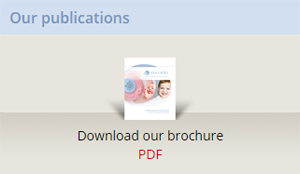- What is In Vitro Fertilization
- Pregnancy rates in IVF
- How is IVF done;
- When to choose IVF
- Is IVF something unnatural?
- Will my child be healthy?
- In Vitro Fertilization risks
What is In Vitro Fertilization
In vitro fertilization (IVF) is the most commonly used ART method. It was first successfully used in the human in 1978.
IVF is the fertilization outside the body (fertilization in the glass as the term describes). Therefore, the interaction of eggs and sperm and subsequent fertilization are achieved in the laboratory instead of taking place naturally in the fallopian tubes.
This is a deviation which overcomes certain barriers that prevent fertilization from occurring naturally within the body. However, in most cases, the eggs are the woman's and the sperm are the man's, so the resulting embryos are genetically theirs.
Pregnancy rates in IVF
Eugonia is an ART Unit with stable and top pregnancy rates.
See more: Pregnancy rates at Eugonia
How is IVF done
The eggs are recovered from the follicles that have developed in the woman's ovaries by the procedure of egg collection. In the laboratory, the eggs come in contact with the sperm inside special dishes with culture medium, in order for fertilization to occur. The fertilized eggs (zygotes) are placed inside an incubator and are cultured under special conditions for 2-6 days, so that the embryos can achieve their first stages of development.
Instead of reaching the uterus naturally, i.e. via the fallopian tube, the embryos are transferred to the uterus by a specialise gynecologist using a thin catheter into which the embryos have been previously loaded by the embryologist. The embryos implant in the endometrium by themselves just like in natural conception. If implantation occurs then a pregnancy will follow.
When to choose IVF
There are absolute and relative indications concerning one or both partners.
Absolute indications are:
- Lack (following removal) or obstruction of fallopian tubes centrally or peripherally (hydrosalpinges).
- Lack of spermatozoa (azoospermia) requiring surgical retrieval.
- Very low number of motile normal spermatozoa (severe oligo-asteno-teratozoospermia).
Relative indications include:
- Long period of infertility
- Age
- Severe sperm-related problems (severe oligo-asteno-teratozoospermia)
- Unexplained infertility
- Failure of other methods (i.e. ovulation induction for timed intercourse or IUI)
- Severe endometriosis
- Preimplantation genetic diagnosis (PGD) for β-thalassaemia, sex-linked diseases, special inheritable diseases*
- Prior to chemotherapy*
- Donation of eggs, sperm or embryos*
- Surrogacy *
* Rare indications
When in vitro fertilization is undertaken for the first time, especially in cases of unexplained infertility, it can also be used as a diagnostic tool: i.e. a detailed record of gamete behavior, fertilization, embryo development and other parameters is kept. This means that following treatment, the reason of infertility can be established from all these details recorded.
Is IVF something unnatural?
Conventional IVF does not violate the laws of natural conception. Despite certain phobias of the public, IVF takes place in the laboratory without further intervention in the interaction of the gametes, while embryo implantation occurs unaided.
Other versions of conventional IVF, such as ICSI, are indeed intrusive methods, but are used to overcome certain problems, most often related to sperm.
In all cases however, if a pregnancy is achieved, it progresses in exactly the same way as following a natural conception.
Will my child be healthy?
IVF children are as healthy and normal as children conceived naturally, and do not present a significant increase in related and chromosome abnormalities, as shown by several large scale epidemiological studies.
This is confirmed by the fact that more than 1.5 million children have been born to date following IVF, and some of them have already had children of their own.
In Vitro Fertilization risks
In general, in vitro fertilization is a risk free and effective method for a subfertile couple to have their own baby. The worries of the public, especially for those that are not aware, although understood, are almost without any basis.
The risk of pharmaceutical stimulation of ovarian function which is called ovarian hyperstimulation syndrome (OHSS), is thought to appear in its severe form in about 1% of all the women that undertake in vitro fertilization treatments. It is a side-effect that can nowadays be prevented in the majority of cases and can also be effectively managed. The scientific team of Eugonia has already published five original studies for the management of established severe OHSS in internationally renowned scientific journals.
The risk of analgesia/light sedation that is administered during egg collection is comparable to any other risk of a simple surgical procedure.
The risk of developing ovarian, uterine or breast cancer is exactly the same as in the general population, as all large international epidemiological studies show. However, breasts should always be examined, especially in women above 35 years of age.































